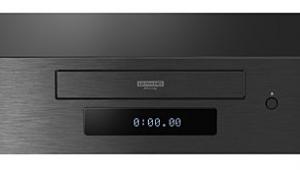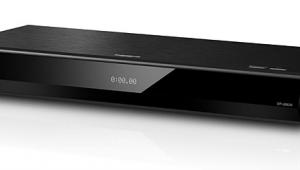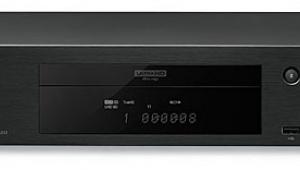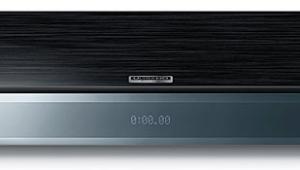Pioneer BDP-51FD Blu-ray Player
Pioneer unveiled its first non-Elite Blu-ray player with the BDP-51FD. At first glance, its large chassis and high-gloss appearance might make you think it’s an Elite line player. However, this player is the first of the classic Pioneer line.

The BDP-51FD is a Profile 1.1 player that supports Bonus View features but lacks a LAN connection and BD-Live support. At $599, I was a bit surprised that it lacks BD-Live or an upgrade path to BD-Live, but the rest of the feature set is pretty impressive.
The player has a very upscale, Elite-ish look despite the price point. The case stands about twice the height of most of the players at this price point and features a high-gloss black front panel. You can dim the front-panel display or turn it completely off, which is a feature I always love to see. The front-panel readout gives you the standard info along with frame rate and audio format, which is pretty handy. There are smaller buttons for Eject and Skip and larger buttons for Play and Power.
The BDP-51FD transmits both Dolby TrueHD and DTS-HD Master Audio lossless as native bitstreams over its HDMI output. However, it only offers internal decoding (to PCM or analog) of TrueHD. The back panel features a full 7.1-channel analog audio output for Dolby TrueHD lossless, but it doesn’t support DTS-HD Master Audio beyond decoding of the backwards-compatible 1.5-megabit-per-second DTS core stream. At press time, Pioneer informed us that it’s readying a firmware update to upgrade the player to full DTS-HD MA decoding but did not provide a date.

Pioneer hasn’t forgotten its roots as an audio company, either. The BDP-51FD uses four discrete Wolfson Stereo DACs for digital-to-analog conversion and includes a jitter-reduction circuit for premium analog audio playback with CDs. In addition, when you play CDs, the BDP-51FD can take advantage of the PQLS circuits in the Pioneer Elite SC-07 and SC-09TX AVRs for additional jitter reduction.
The HDMI output is 1.3a and includes support for Deep Color, should it ever surface in the consumer market. It also includes standard analog video connections, along with TosLink and digital coaxial options.
The BDP-51FD features Pioneer’s Home Media Gallery, which lets you burn CDs or other media files to the player for playback from the internal drive. This also works with pictures.
 Setup is pretty straightforward, and the player initially greets you with a simple setup walkthrough. Some of the labels are a bit confusing in terms of audio and HDMI connections. I wish manufacturers would standardize their nomenclature for audio and video output options. This player asked if my HDMI connection was a high-rate cable. That was the first time I’d heard it referred to in this manner, so I can only imagine what consumers will think.
Setup is pretty straightforward, and the player initially greets you with a simple setup walkthrough. Some of the labels are a bit confusing in terms of audio and HDMI connections. I wish manufacturers would standardize their nomenclature for audio and video output options. This player asked if my HDMI connection was a high-rate cable. That was the first time I’d heard it referred to in this manner, so I can only imagine what consumers will think.
Once I got into the main setup screens, I found the level of detail in the setup impressive. This is one of the only players I’ve seen that lets you select what color space you want it to output. I’m also glad to see that Pioneer included its source-direct mode for video playback. This feature automatically outputs the native resolution and frame rate of the source material on the disc.
The BDP-51FD includes video memories that are tailored for specific display types or a user memory to set your own configuration. These menus include a wealth of noise reduction options and some adjustments for Pioneer’s PureCinema progressive-scan modes.
For the analog output, Pioneer includes full channel-level controls and limited bass management.
The remote isn’t the most intuitive I’ve used, and I was disappointed by the player’s response times. When I pressed a key, it took several seconds for the player to respond, which made me wonder whether it took the command or not. This is frustrating when you’re trying to navigate menus or skip chapters.
Without a doubt, this is the slowest recent-generation player I’ve used. Compared with the Panasonic players I had on hand, this was a battle with frustration. BD-Java titles took forever to load, and navigating through the trailers and menus was migraine inducing. Right now, I think this is the biggest stumbling block of the Blu-ray format as a whole. As more adopters come over from DVD, I don’t think they expect a huge step back in operability and load times. This is supposed to be a next-generation experience for audio and video as well as interactivity. When interaction is this frustrating, I don’t see Blu-ray getting good word of mouth from its new users. This player just wasn’t competitive with the faster standalones I’ve recently reviewed from Panasonic and Samsung.
Video Performance
Pioneer’s players have always been some of the best performers when it comes to standard 1080p/24 playback. This one is no exception, even if it isn’t quite as dialed in as the Elite players I’ve reviewed. Sure, this player does a fantastic job with the high-resolution 1080p content, but I did notice a small amount of ringing in some fine detail. Hard edges were also a bit noticeable, which led me to believe Pioneer applied a bit of sharpening to the output.
With the player set for 1080p/60, there was an obvious loss of resolution with chroma information in our test patterns. I couldn’t overcome this, regardless of the settings I applied in the video setup menus. This only applied to the 1080p/60 output and not the native 1080p/24 output.
Pioneer made significant improvements to its video processing. The Elite models did not pass our deinterlacing tests for HD material. Either Pioneer has implemented a new update to its Pure Progressive video processing, or the decoder used in the player is a different model with different capabilities. Regardless of the situation, this inexpensive BDP-51FD did a better job than the previous Elite models. It produced strong results overall.
The player was slower to lock onto a 3:2 cadence with 1080i material than most players I’ve seen. It took a few seconds to lock on rather than a few frames. This shouldn’t affect playback much, but some light combing may be evident from time to time with 1080i material being deinterlaced.
DVD video processing was good, but I saw combing with static menus. This distracted me throughout most of my testing and was unlike previous Pioneer models I’ve tested before. Thankfully, this didn’t manifest with normal video playback.
In Use
As I mentioned before, this player’s operability is pretty frustrating. This applies to Blu-ray and DVD playback equally. DVD load times were quite excessive, and menu navigation and interaction were unacceptable. Once I had a disc playing, the BDP-51FD did deliver the goods, with great-looking HD video and audio support. I saw some slight edginess with 1080p/24 playback, but the subtle boost does give the image a perceived increase in sharpness that some people may like.
Wrapping Up
Although Pioneer definitely made some strides in its video performance, this player is a step back in basic operability and speed compared with other recent entries in the market. Combined with the BDP-51FD’s BD-Live incompatibility, this isn’t a player I can recommend given the state of the market today, in spite of its strengths in other areas of performance.
- Log in or register to post comments






























































